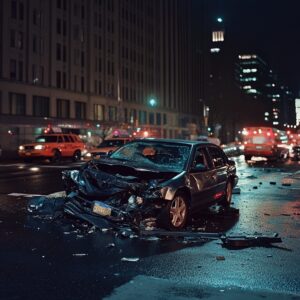
The screech of tires, the jolt of metal, and the deafening silence that follows—it all happens in an instant. You’re sitting behind the wheel, heart pounding, trying to piece together what just unfolded. In your rearview mirror, two cars are smashed. Ahead, brake lights blur in the smoke. Before you can speak, another driver shouts, “You cut me off!” while someone else insists, “I was hit from behind!” In a matter of seconds, a car accident becomes a battleground—and you’re caught in the middle.
Multi-driver collisions are some of the most complex cases in personal injury law, especially under West Virginia’s unique liability rules. Everyone involved may have their own version of events, and with insurance companies eager to assign blame anywhere but their own client, the truth can quickly get buried. The Tiano O’Dell Charleston car accident lawyers understand the high stakes and tangled narratives these accidents produce—and they know how to untangle them, piece by piece.
When No One Wants to Take the Fall
The immediate aftermath of a crash involving multiple vehicles often looks more like a courtroom than a crash site. Each driver is forming a defense: “They braked too suddenly,” “She swerved into my lane,” “He was tailgating.” The problem? Liability isn’t always obvious, and when everyone’s pointing fingers, it’s easy for the wrong person to take the blame.
Without the right evidence and legal guidance, you may find yourself absorbing fault that isn’t yours. In West Virginia, that can be devastating. Even if you’re only slightly over the 50% fault threshold, you lose your right to recover damages entirely. That’s why asserting your version of the truth early—and backing it with proof—is critical.
The 51% Line Between Justice and Nothing
West Virginia’s “modified comparative fault” rule means you can only recover compensation if you’re less than 50% responsible for the accident. If you’re found 51% at fault—even if others also played a role—you walk away with nothing. No medical bill coverage. No lost wages. No compensation for pain and suffering.
This razor-thin rule gives insurance companies every incentive to inflate your share of the blame. They may comb through your driving history, twist your words from the crash scene, or argue that a split-second mistake on your part triggered the chain reaction. An experienced legal team knows how to push back, presenting evidence that not only defends your actions but holds the real culprits accountable.
When the Truth Is in the Details
In a world where everyone’s memories clash, cold, hard evidence tells the most honest story. Skid marks that show braking patterns. Crumple zones that indicate impact direction. Traffic light cycles. Dash cam footage. Even cell tower pings. These seemingly small details can unravel false claims and reconstruct what really happened.
The key is collecting this evidence fast. Traffic camera footage can be overwritten within days. Witnesses move. Scenes are cleared. That’s why working with attorneys who treat the crash like a forensic investigation—and move quickly to secure every angle—can be the difference between blame and justice.
The Domino Effect of Chain-Reaction Crashes
In a three- or four-car pileup, liability often starts with a single misstep. One driver slams the brakes without warning. Another is texting. A third is tailgating. Before you know it, metal meets metal down the line. Who’s truly at fault? Is it the first driver? The last? Someone in between?
Liability may be shared, or it may be traceable to one reckless decision. Skilled legal teams dissect these incidents with accident reconstructionists who specialize in multi-vehicle crashes. They use math, physics, and technology to determine who started the chain and who simply had no chance to stop it.
You Don’t Have to Be the Loudest—Just the Best Prepared
In the confusion of conflicting stories, it’s easy to feel overpowered, especially if the other drivers are more aggressive or have already made their statements. But building a strong case doesn’t require shouting the loudest. It requires showing up with facts, witnesses, and a rock-solid narrative that no insurer can easily dismiss.
Legal advocates help shape that story, from coordinating your medical records and witness statements to ensuring your words aren’t twisted in recorded interviews. They work quietly, effectively, and with precision, so that when the negotiations begin, you’re not outnumbered. You’re ready.
Insurance Companies Are Not Referees
It’s tempting to believe the insurance companies will sort things out fairly. They won’t. Each adjuster is there to protect their company’s bottom line, not to uncover the truth. In a multi-car crash, they’re more like players in the game, not referees. And they’ll happily let you take the fall if it means they pay less.
That’s why representation isn’t just helpful—it’s necessary. Without someone advocating purely for your interests, you’re playing a game that’s already rigged. An attorney levels the field, forcing insurers to acknowledge facts instead of fiction.
Medical Claims Get Tangled Too
When liability is unclear, even your injury claim can get trapped in legal limbo. Insurers may argue that another driver should pay, delay your treatment authorization, or offer far less than what your recovery truly requires. Meanwhile, you’re stuck in pain, watching bills pile up.
A well-prepared legal team fights to ensure your injuries are taken seriously, your care is covered, and your settlement includes everything from physical therapy to future income loss. They don’t just address who was at fault—they connect the crash to the cost of getting your life back.
The Crash May Be Over—But the Fight Is Just Beginning
The worst is supposed to be behind you after a crash. But when multiple drivers point fingers and insurers pull strings, the real damage can come later—if you’re not prepared. In West Virginia, where the difference between 49% and 51% can cost you everything, your case needs more than a solid claim. It needs a strategy. It needs speed. And it needs someone who understands the battlefield.
That’s where the legal team makes all the difference. When the accident scene becomes a war of words and percentages, having advocates who know how to reconstruct, negotiate, and fight ensures you won’t be left behind, blamed, bruised, and uncompensated.




